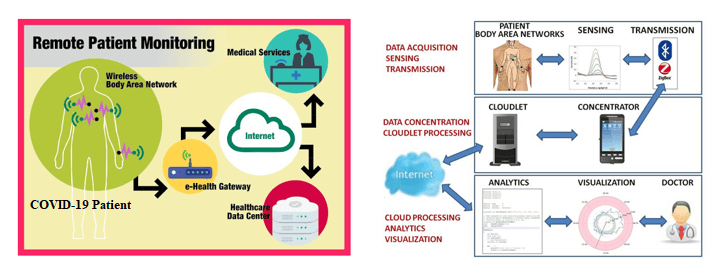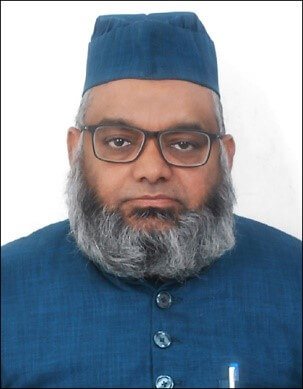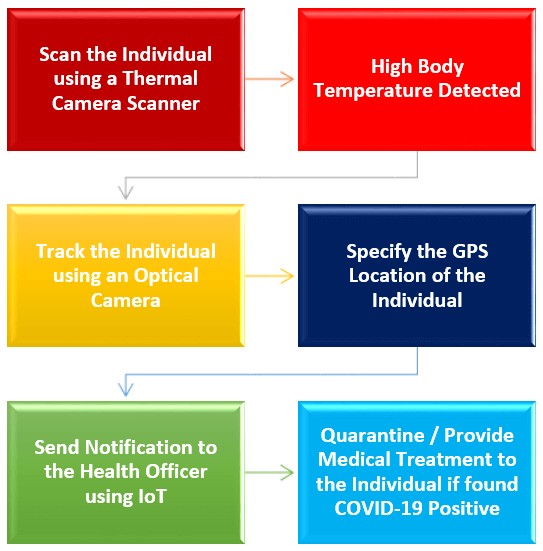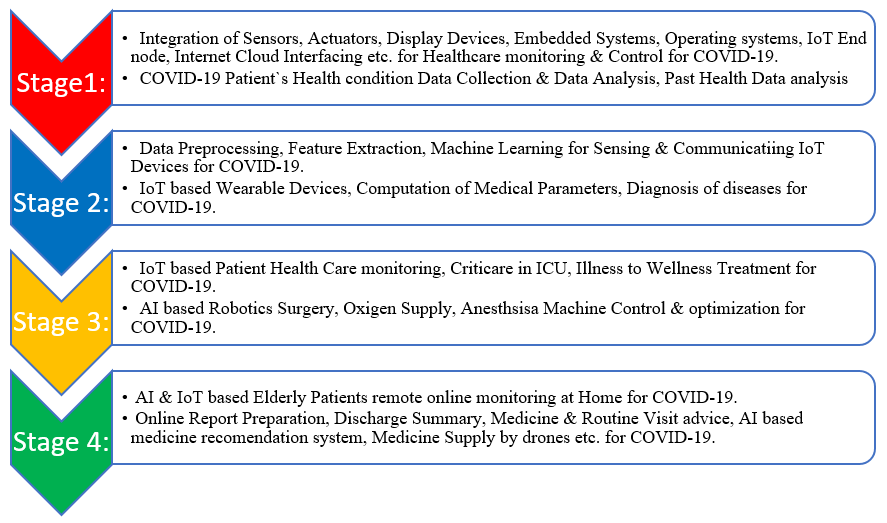Artificial Intelligence, Machine Learning & Internet of Medical Things (IoMT) for COVID-19 & Future Pandemics: An Exploratory Study
Written by Himanshu Sharma1 and Ahteshamul Haque2*
The COVID-19 pandemic has significantly affected millions of human lives in the entire world. Worldwide healthcare professionals are working day and night for the treatment of COVID-19 patients. In this critical situation, Artificial Intelligence (AI), Machine Learning (ML) & the Internet of Medical Things (IoMT) technologies can play an important role in efficient vaccine distribution and treatment of COVID-19 patients. In smart cities, smart hospitals are generally equipped with IoMT devices. The IoMT devices are used for sensing, monitoring and control of patient health data, such as respiration rate, blood pressure, blood sugar, heartbeats rate, and other critical health parameters. A typical IoMT scenario consists of an intensive care unit (ICU), various medical instruments, and a wireless body area network (WBAN) connected to the internet. A WBAN consists of sensors and actuators which can be placed on clothes, over and under the human skin. In this article, we outline how IoMT-based healthcare solutions, powered by AI and ML techniques, can be used to combat COVID-19 and future pandemics in support of smart healthcare in smart cities.
1. Introduction
Coronaviruses are a large family of viruses that are known to cause illnesses ranging from the common cold to more severe diseases, such as Middle East Respiratory Syndrome (MERS) and Severe Acute Respiratory Syndrome (SARS). The term COVID-19 has its meaning, as the first two letters (‘CO’) stand for corona, 'VI' for virus, and 'D' for disease, which started in the year 2019, hence named as COVID-19 by the World Health Organization (WHO). According to the latest report of the WHO, as of June 2021, the number of confirmed COVID-19 cases surpassed 180 million people, with a huge death toll number of approximately 4 million people [1]. The research and development teams in medical companies have developed vaccines that are being supplied worldwide to the frontline workers, such as the Pfizer COVID-19 vaccine (BNT162b2). The AI and ML techniques, such as regression, classification, and clustering, can be useful for the efficient treatment of COVID-19 patients, and for COVID-19 vaccinations. A new vaccine named as COVAXIN® - India's first Indigenous COVID-19 Vaccine by Bharat Biotech is developed in collaboration with the Indian Council of Medical Research (ICMR) in 2021.
2. Artificial Intelligence (AI) & Machine Learning (ML)
AI refers to the ability of machines to perform cognitive tasks like thinking, perceiving, learning, problem-solving, and decision making. ML is a part of AI in which computer algorithms learn how to make decisions to become more efficient. The term ML was coined by Arthur Samuel in 1959, which meant “the ability to learn without being explicitly programmed.” Internet of Things (IoT) refers to the network of objects which can be connected to the internet to perform a specific task. The combined powers of AI, ML, and IoT can be utilized for COVID-19 disease patient treatments effectively. Internet of Medical Things (IoMT) can be defined as the application of the fundamental techniques of IoT for the medical and healthcare sectors and domains.

Fig. 1(a) Remote monitoring of COVID patients Fig. 1(b) Data modelling and analysis
3. Remote Monitoring of COVID-19 Patients
Fig. 1(a) shows remote monitoring of a COVID-19 patient using sensors, gateway, internet and a data centre. Fig. 1(b) shows data acquisition, sensing and transmission of patient health data using connectivity technologies like Bluetooth, ZigBee (IEEE 802.15.4 standard) [2], Narrow Band Internet of Things (NB-IoT) [3], and Low Power Wide Area Networks (LoRaWAN) [4] wireless communication protocols. The patient health data is observed on the mobile application. The same data is subsequently sent to the cloud over the internet. At the cloud server, various ML techniques like regression, classification and clustering algorithms are used for patient’s health data analysis, medicine recommendation and treatment. The doctor can visualize the patient health data over the smartphone. COVID-19 patient health information includes blood group, oxygen level, heart beats monitoring, and clinical metrics. The patient’s health information is analysed using classification, clustering, regression & Artificial Neural Networks (ANN) techniques for COVID-19 symptoms [5,6].
Fig. 2 Scanning of Suspected COVID-19 Patients at Crowded Places
The scanning procedure for COVID-19 suspected people is shown in Fig. 2. Generally, public places, such as airports, railway stations, bus stands, shopping malls, etc., are visited by many people on a daily basis. In such places, thermal scanning by robotics machines can be performed to identify people with a high temperature and notify public health officers for their actions. People can be identified using vision cameras and can be traced using their GPS location. If people are found to have COVID-19, they can be quarantined or treated immediately, so that the disease does not spread to others. For example, in India, the Government of India has launched an application software named “Arogya Setu Mobile App” which can be easily installed from the Google Play store in mobile phones. The “Arogya Setu App” continuously keeps track of human body temperature using Bluetooth and sends the COVID-19 diagnosis report to the central health monitoring database server. This is an efficient way of live health monitoring of millions of people in India. In the “Arogya Setu mobile app” users consent to having their health monitored and their data used for diagnosis.
3. Process Workflow Chart for Treatment of COVID-19 Patients
Fig. 3. shows the process workflow for the treatment of COVID-19 patients, which can also extend to patients of future pandemics. There are four stages, as explained below:
Stage 1: In the first stage, the integration of various medical sensors, and embedded systems are considered.
Stage 2: In the second stage, the COVID-19 patient healthcare data is analysed to determine the severity of the condition. If the condition is serious then the patient is immediately admitted to the hospital for treatment.
Stage 3: In the third stage, AI, ML and IoT techniques are applied based on the received patient health data.
Step 4: In the fourth stage, after the patient is treated, tasks such as patient quarantine and medicine recommendation take place.
Fig.3. Process Workflow Chart for Treatment of COVID-19 Patients & Future Pandemics
4. Conclusion
This article discussed the role of smart IoT-based technologies in COVID-19 prevention & cure to support early diagnosis, treatment, quarantine strategies, and after-recovery care. Moreover, the article presented a process flow to support the detection and treatment of COVID-19 patients using AI, ML and IoMT technologies. The proposed workflow is not specific to COVID-19 and can be extended to support future pandemics.
References:
- World Health Organisation (WHO) Weekly epidemiological update on COVID-19 - 29 June 2021, edition 46, URL : https://www.who.int/publications/m/item/weekly-epidemiological-update-on-covid-19---29-june-2021
- IEEE Standard Documentation on “802.15.4-2020 - IEEE Standard for Low-Rate Wireless Networks”, (Revision of IEEE Std 802.15.4-2015), IEEE, 2020.
- Emmanuel M. Migabo; Karim D. Djouani; Anish M. Kurien “The Narrowband Internet of Things (NB-IoT) Resources Management Performance State of Art, Challenges, and Opportunities”, IEEE Access, Vol.8, pp. 97658 – 97675, year 2020.
- Jothi Prasanna Shanmuga Sundaram; Wan Du, “A Survey on LoRa Networking: Research Problems, Current Solutions, and Open Issues”, IEEE Communications Surveys & Tutorials , Volume: 22 Issue: 1,pp. 371 – 388, Year 2019.
- Xinggang Wang;Xianbo Deng;Qing Fu;Qiang Zhou;Jiapei Feng;Hui Ma;Wenyu Liu;Chuansheng Zheng, “A Weakly-Supervised Framework for COVID-19 Classification and Lesion Localization From Chest CT”, IEEE Transactions on Medical Imaging, Volume: 39, Issue: 8, Year: 2020
- Hamed Jelodar;Yongli Wang;Rita Orji; Shucheng Huang, “Deep Sentiment Classification and Topic Discovery on Novel Coronavirus or COVID-19 Online Discussions: NLP Using LSTM Recurrent Neural Network Approach”, IEEE Journal of Biomedical and Health Informatics, Volume: 24, Issue: 10, Year: 2020.
Keywords: Artificial Intelligence (AI), Machine Learning (ML), Internet of Medical Things (IoMT), Wireless Body Area Networks (WBAN)
1 Department of Electronics & Communication Engineering, KIET Group of Institutions, Delhi-NCR, Ghaziabad, U.P, India. himanshu.sharma@kiet.edu
2* Corresponding Author, Advance Power Electronics Research Lab, Department of Electrical Engineering, Jamia Millia Islamia, New Delhi. India. ahaque@jmi.ac.in
This article was edited by Aris Gkoulalas-Divanis
For a downloadable copy of the August 2021 eNewsletter which includes this article, please visit the IEEE Smart Cities Resource Center.


To have the eNewsletter delivered monthly to your inbox, join the IEEE Smart Cities Community.
Past Issues
To view archived articles, and issues, which deliver rich insight into the forces shaping the future of the smart cities. Older eNewsletter can be found here. To download full issues, visit the publications section of the IEEE Smart Cities Resource Center.





